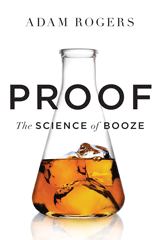|
|
 |

Proof--The Science of Booze, by Adam Rogers, may not be a book for everyone (the anti-alcohol crowd probably won’t be interested), but it’s hard to imagine any serious wine drinker who wouldn’t find Proof chockablock full of fascinating facts and information. The writing is clear, concise, and full of humor in a very readable style that’s even more  impressive from a writer who specializes in science and technology (the award winning author is currently articles editor at Wired.) impressive from a writer who specializes in science and technology (the award winning author is currently articles editor at Wired.)
Divided into eight chapters, Proof begins with “Yeast” (which Rogers describes as a microbe that was domesticated “The same way we domesticated dogs and cattle, to do a job: make drinks”). Ending as any good alcoholic binge might, the final chapter is titled “Hangover.” The journey from yeast to hangover focuses not only on wine, but every bit as much on the makings of a good cocktail, and on beer. (Of the latter, Rogers writes: “Some scientists and anthropologists have argued that the production of beer induced human beings to settle down and develop permanent agriculture--to literally put down roots and cultivate grains instead of roaming nomadically. The manufacture of alcohol was, arguably, the social and economic revolution that allowed Homo sapiens to become human beings. It’s the question of human life on earth. It’s a miracle.”)
Trying to sum up any book in a handful of short paragraphs does it little justice, but the impressively lucid organization of this one can be abbreviated in what I hope will give a general idea of its overall relevance. The first two chapters transition logically from yeast to sugar (yeast “is neither plant nor animal, neither bacteria nor virus,” but rather a single-celled fungus that feeds on sugar). While sugars in most fruits are readily digested by yeast, grains--such as the rice that is the basis for alcoholic beverages throughout Asia, and the rye and corn that produce whisky--present a separate problem as their sugars are mostly locked in Lego-like polymers that yeasts can’t break apart. “So no matter where they lived,” Rogers says, “if human beings wanted to make booze—and they really, really did--they had to figure out how to crack starch.”
The result of yeasts feasting on sugars is fermentation, the subject of chapter 3. “Fermentation isn’t an accident, or a byproduct,” Rogers writes. “It’s the way yeasts convert what they eat to energy. That’s metabolism.” Ethanol and other metabolites; bubbles and Carbon Dioxide; experimental archaeology and sour mash--all of this, and much, much more, gets covered in this chapter, for as Rogers states, “Clearly there’s more to fermentation than spinning glucose into ethanol.”
Fermentation, as the author describes it, is as natural a process imaginable. By contrast, distillation (chapter 4) is a miracle of science, it is technology that we’ve learned to harness and adapt over human history. (“To distill, literally or metaphorically, requires the hubris to believe you can change the world.”)
One might expect the next chapter, “Aging,” to lead us straight down into a cool, quiet cellar filled with bottles or barrels, but instead the reader is dropped into an eerie neighborhood in Lakeshore, Ontario, just across the river from Detroit, which has been invaded by a mysterious black mold. The black gunk covers everything: building walls, chain-link fences, street signs, even an abandoned stainless steel tank. (“Stainless steel!” exclaims Rogers. “The whole point of stainless steel is that things don’t grow on it.”) Where did this sinister fuzz come from? No one, not even university scientists, could solve the mystery until Canadian mycologist James Scott was finally able to identify it as a new mold growing on the angel’s share emitted by local distillery warehouses. (More recently complaints, and lawsuits, in Kentucky charge that homes and street signs there have been covered with the same furry black residue produced by the local Bourbon industry.)
“Smell and Taste” is a chapter filled with stimulating thoughts information about the language we use to describe wine, and what our senses actually perceive when we taste it. “Nobody’s sure whether ethanol makes a red wine taste better,” the author writes, “but from experience I’ll tell you that while non-alcoholic beer can be pretty good, ‘de-alcoholized’ red wine tastes like existential death.”
“Body and Brain” looks at the physical and mental effects of alcohol. Much of the science of how ethanol affects us is still murky, though it seems clear that other factors in addition to alcohol are involved in intoxication. And if you want to learn why a bartender knows when to cut you off well before a Breathalzyer would, you’ll find the answer here.
“Good mornin, sunshine! You are so screwed. The light coming in through the window is so…there.” Yes, we’ve reached the final chapter, “Hangover,” which offers us much to contemplate. Hangovers are generally painful, occasionally amusing (at least to the unaffected), and have a sizeable economic impact on society. A sample factoid: In the US, some $160 billion a year in productivity is lost due to people who can’t make it into work because of hangovers. Another bit of hangover trivia: 23% of people do not get hangover (“the scientific name for them is ‘jerks’”). But the most interesting thing by far about hangovers is that whatever you learned about them in college is not true. Apparently no one knows what causes billions of people to have hangovers, or how to treat them. The subject has barely been studied by scientists. You think your hangover is due to dehydration? Sure, drinking booze dehydrates you, but as various measurements of electrolytes and such show, that doesn’t cause the hangover (“Plus, drink a glass of water,” suggests Rogers. “Now you’re hydrated. Did your hangover go away?”). Acetaldehyde, blood sugar levels, lactate levels--none of these can (so far) be proven to cause hangovers.
Okay, we don’t know why you’re miserable the morning after, but surely science knows how to make you feel better? Nope. Chinese herbs, IV therapy, electrolyte drinks, vitamin supplements, aspirin, dancing to sweat out the toxins, prostaglandin inhibitors, prickly pear cactus extract, hair-of-the-dog--none of these have proven to be reliable hangover cures. Adam Rogers actually tried his own informal study on possible remedies, which involved a couple of friends and a lot of booze. (If you want to try replicating this experiment yourself don’t blame him--or me--for the inevitable aftermath.)
Proof’s final chapter is the only one that didn’t make me want pour myself a glass of wine, or beer or whisky, and I guess that’s a good thing. I was sorry, however, to finish the book. But with new yeast strains coming along (including some that make flavorful wine with lower alcohol levels); with climate changes, and different grapes and different viticultural regions emerging, and of course with genetically modified everything fast approaching; with small craft brewers and distillers multiplying everywhere--well, things are changing. In fact, concludes Rogers, “Maybe, even further in the future, something will replace ethanol altogether…an alcohol replacement that would have the same effects…but it’d be reversible, with an antidote that would instantly sober up a user, or cure a hangover.” Bring it on, I say, and bring on the book Adam Rogers will surely write about it.
* * *
Proof--The Science of Booze
Adam Rogers
2014 (Houghton Mifflin Harcourt Publishing Co.)
|
 |
|